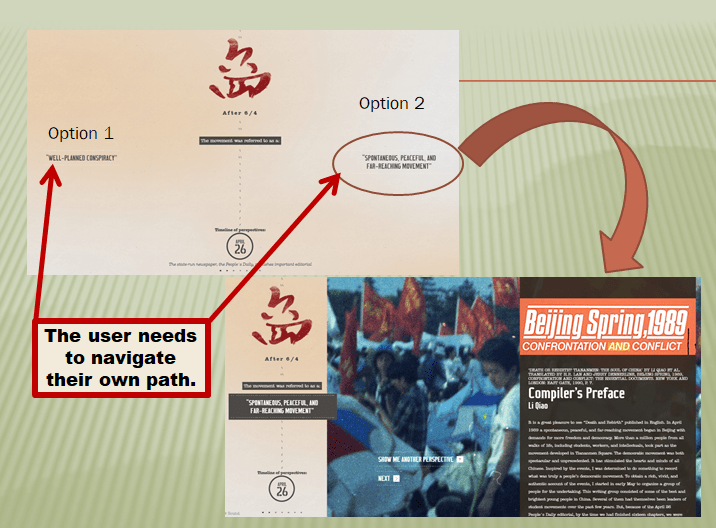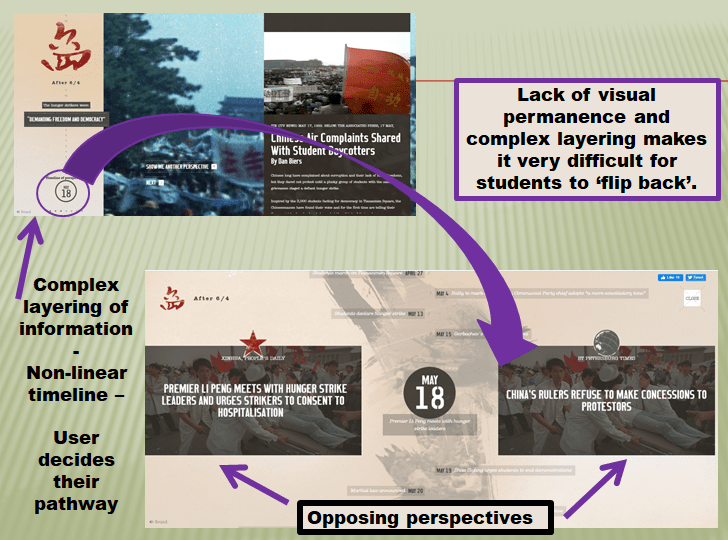RESOURCE 1 – After 6/4
After 6/4 is a collation of differing viewpoints of the Tiananmen Square event in Beijing 1989. Created as an anniversary tribute, After 6/4 contains a range of primary sources, news headlines, videos and personal anecdotes using VR, animation, audio, 360 video and other archival storytelling (Chen & Heald, 2014). This digital assemblage of primary sources remains a valuable teaching tool about persuasive texts, multimodal media literacy, and even more so in the light of the recent Hong Kong protests.
Curriculum Links:
- Asia and Australia’s Engagement with Asia: (OI: 5 and 7)
- Year 8 English (ACELA1543)- Main value to collection.
- Year 9 Media Arts (ACAMAM073, ACAMAR078, ACAMAR079)
- Year 9 History – (ACDSEH146)
- Senior History curriculum – Unit 4.
Learning, Literacy and Language: 
After 6/4 provides a vibrant learning experience as readers navigate their way through varied perspectives on a non-linear timeline. The reader is required to assimilate the primary sources, make an evaluative decision and interact with the text. This complex navigation requires higher-order thinking as students explore the multimodal perspectives, and correlate them to the state-sanctioned or author’s bias (Kopka, 2014). After 6/4 clearly accentuates the power of persuasive language and its impact on the reader. It also highlights the dichotomy of free press versus state sanctioned media, and requires the reader to develop their own conclusion about the complexity of historical and media partisanship that is pervasive in modern society (Lamb, 2011, p.15). This transmedia resource challenges students to develop their multiliteracies, critical thinking skills, and understand essential media conventions (Kopka, 2014).
It is popular knowledge that video and computer gaming are very popular with teenagers, and After 6/4 challenges young people to utilise their transliteracy expertise for educational needs (Kopka, 2014). After 6/4 elicits the reader’s interest by requesting them to select their country of origin then linking to a range of multimodal media texts. Readers are further rewarded by additional information as they ‘click’ through the timeline. By offering language choices in both English and Mandarin, After 6/4 allows the reader to interact with the text without the need for a translator. The resource is further supported by subtitles which promotes literacy development and helps lower literacy students engage with the content material. 
Interactive resources such as After 6/4 are useful in engaging disengaged learners and reluctant readers into subject matter than may normally be of limited interest to them (Kopka, 2014; Raja & Kumar, 2010). The appeal arises from the rhetoric of grasping and gamification theory prevalent in many interactive websites, which has a positive correlation to motivation (Heckman & Bourchardon, 2012; Kopka, 2014).

After 6/4 requires the reader to physically manipulate the screen making the interaction more maningful and further immersing the reader into the text. This is because interactive and hypertext media allow the reader to encounter and practise both efferent and aesthetic reading practices, which is essential for the development of both online and offline reading skills (Pietschmann, Volker & Ohler, 2014). Unfortunately, this immersive experience and features such as, parallax scrolling, non linearity and lack of visual permanence require the teacher to provide extensive scaffolding for students with learning disabilities (Raja & Kumar, 2010; Botzakis, 2018).
Technology Trends:
The inclusion of interactive websites into classroom practice, advocates for the presence of technology as part of modern societal practices (Ross Johnston, 2014b, p.633). Transmedia resources promote 21st century skills such as, experiential learning, critical thinking, as well as the development of trans-literacies (Cullen, 2015; Pietschmann, Volker & Ohler, 2014; Kopka, 2014; Leu et al., 2015). Interactive media is a rapidly emerging digital format and needs to be part of education to ensure students develop the necessary skills for life in the 21st century (Leu et al., 2015).
Resource Integration:
After 6/4 is a locally produced interactive website and is freely available online with no licencing limitations, making it a very thrifty resources. Interactive websites can be integrated into the library management systems, LibQuests and class intranet pages, as well as embedded into class documents, and accessible from a range of devices. This makes After 6/4, a valuable teaching tool for digital and media literacy. The only caveats are that this DL requires the internet to access and interact with, and this could be an issue for rural, remote and low income households (DIIS, 2016). Therefore it would be recommended that After 6/4 is used in the classroom for teaching and learning rather than being tasked for homework. Additionally, as the resource is found on the internet, there is no guarantee it will be freely available indefinitely so caution is required when unit planning.
Recommendation:
After 6/4 would be a suitable addition to a school collection.
References:
ACARA. (2019). Cross curricular priorities – Asia and Australia’s engagement with Asia. F-10 Curriculum. Educational Services Australia. Retrieved from https://www.australiancurriculum.edu.au/f-10-curriculum/cross-curriculum-priorities/asia-and-australia-s-engagement-with-asia/
ACARA. (2014a). English Curriculum. F-10 Curriculum. Educational Services Australia. Retrieved from https://australiancurriculum.edu.au/f-10-curriculum/english/?strand=Language&strand=Literature&strand=Literacy&capability=ignore&priority=ignore&elaborations=true
ACARA. (2014b). The Arts – Media Arts Curriculum. F-10 Curriculum. Educational Services Australia. Retrieved from https://www.australiancurriculum.edu.au/f-10-curriculum/the-arts/media-arts/
ACARA. (2014b). HASS – History Curriculum – Unit 4. F-10 Curriculum. Educational Services Australia. Retrieved from https://www.australiancurriculum.edu.au/f-10-curriculum/humanities-and-social-sciences/history/
ACARA. (2014c). Modern History – HASS. Senior Secondary Curriculum. Educational Services Australia. Retrieved from https://www.australiancurriculum.edu.au/senior-secondary-curriculum/humanities-and-social-sciences/modern-history/
Botzakis, S. (2018). Comics in the classroom: Using graphic novels for content learning. In D. Wooten, B. Cullinan, L. Liang & R. Allington (Eds). Children’s literature in the reading program: Engaging young readers in the 21st century, (5th ed., pp. 140-152). Retrieved from Proquest Ebook Central.
Briggs, S. (2016). Using gaming principles to engage students. InformED [Blog]. Retrieved from https://www.opencolleges.edu.au/informed/features/using-gaming-principles-to-engage-students/
Cullen, M. (2015, December 21). How is interactive media changing the way children learn. In EducationTechnology. Retrieved from https://educationtechnologysolutions.com.au/2015/12/how-is-interactive-media-changing-the-way-children-learn/
Department of Industry, Innovation and Science. (2016). Australia’s digital economy update. Retrieved from https://apo.org.au/sites/default/files/resource-files/2016/05/apo-nid66202-1210631.pdf
Heckman, D., & Bouchardon, S. (2012). Digital manipulation and digital literature. Electronic Book Review. Retrieved from https://electronicbookreview.com/essay/digital-manipulability-and-digital-literature/
Kopka, S. & Hobbs, R., (2014). Transmedia & Education: Using Transmedia in the Classroom with a Focus on Interactive Literature [Blog]. SeKopka. Retrieved from https://sekopka.wordpress.com/2014/05/07/transmedia-education-using-transmedia-in-the-classroom-with-a-focus-on-interactive-literature/
Lamb, A. (2011). Reading re-defined for a transmedia universe. Learning & Leading with Technology 39(3), p.12-17. Retrieved from https://eric.ed.gov/?id=EJ954320
Leu, D.J, Forzani, E., Timbrell, N., & Maykel., C. (2015) . Seeing the forest, not the trees: Essential technologies for literacy in primary grade and upper elementary grade classroom. Reading Teacher 69: (2), p.139-145. Retrieved from https://eric.ed.gov/?id=EJ1073399.
Pietschmann, D., Volkel, S., & Ohler, P. (2014). Limitations of transmedia storytelling for children: A cognitive development analysis. International Journal of Communication 8, p.2259-2282. Retrieved from https://www.researchgate.net/publication/279323387_Limitations_of_Transmedia_Storytelling_for_Children_A_Cognitive_Developmental_Analysis
Raja, B.W.D., & Kumar, S.P. (2010). Do multimedia applications benefit learning disabled children? Journal of Educational Technology 6 (4). Retrieved from https://eric.ed.gov/?id=EJ1098361
Ross Johnston, R. (2014a). Chapter 23 – Literature, the curriculum and 21st-century literacy. In G. Winch, R. Ross Johnston, P. March, L. Ljungdahl & M. Holliday (Eds.), Literacy: Reading, writing and children’s literature (5th ed., pp. 472-489). Melbourne: Oxford University Press.
Ross Johnston, R. (2014b). Chapter 30 – Visual literacy: Reading the world of signs. In G. Winch, R. Ross Johnston, P. March, L. Ljungdahl & M. Holliday (Eds.), Literacy: Reading, writing and children’s literature (5th ed., pp. 618-636). Melbourne: Oxford University Press.

